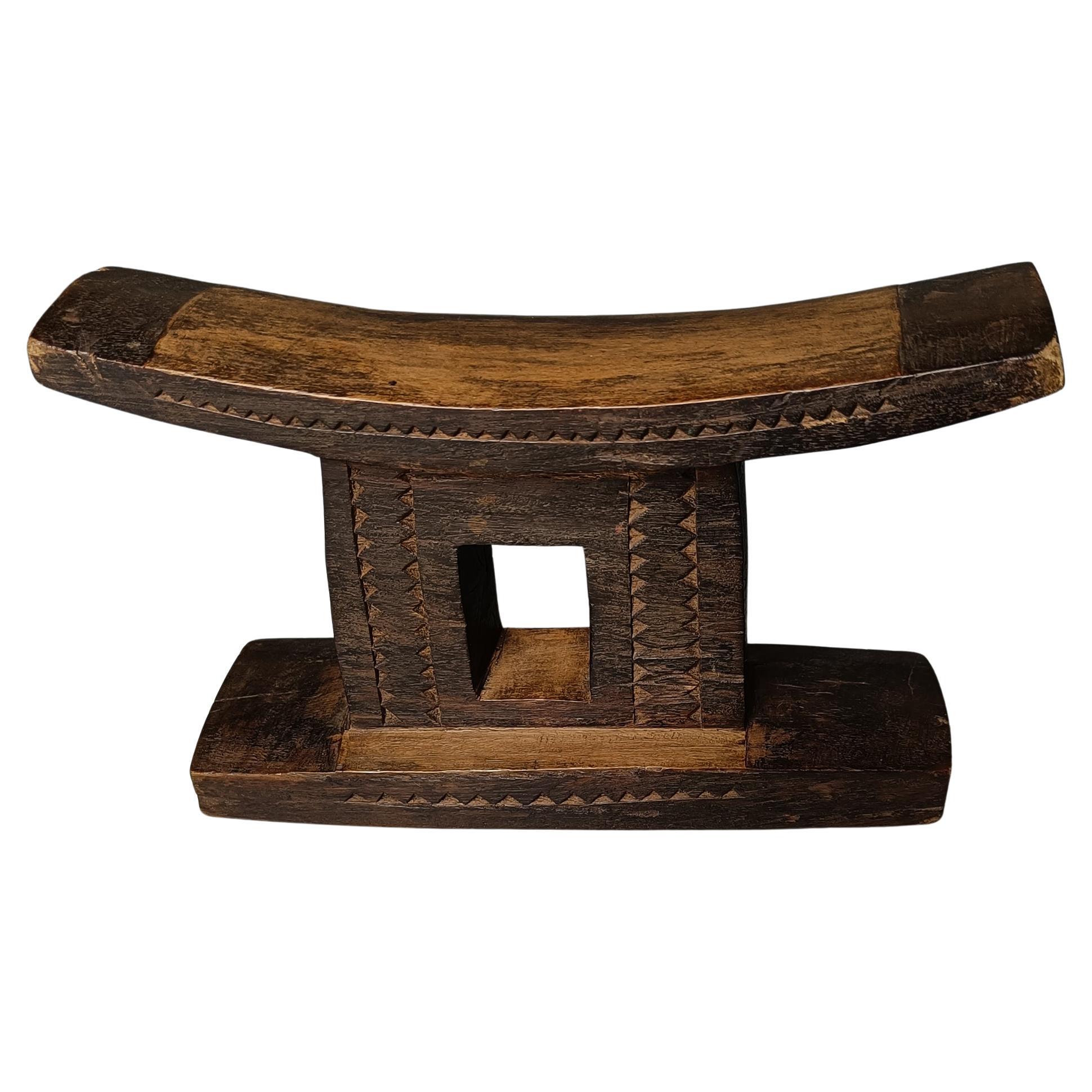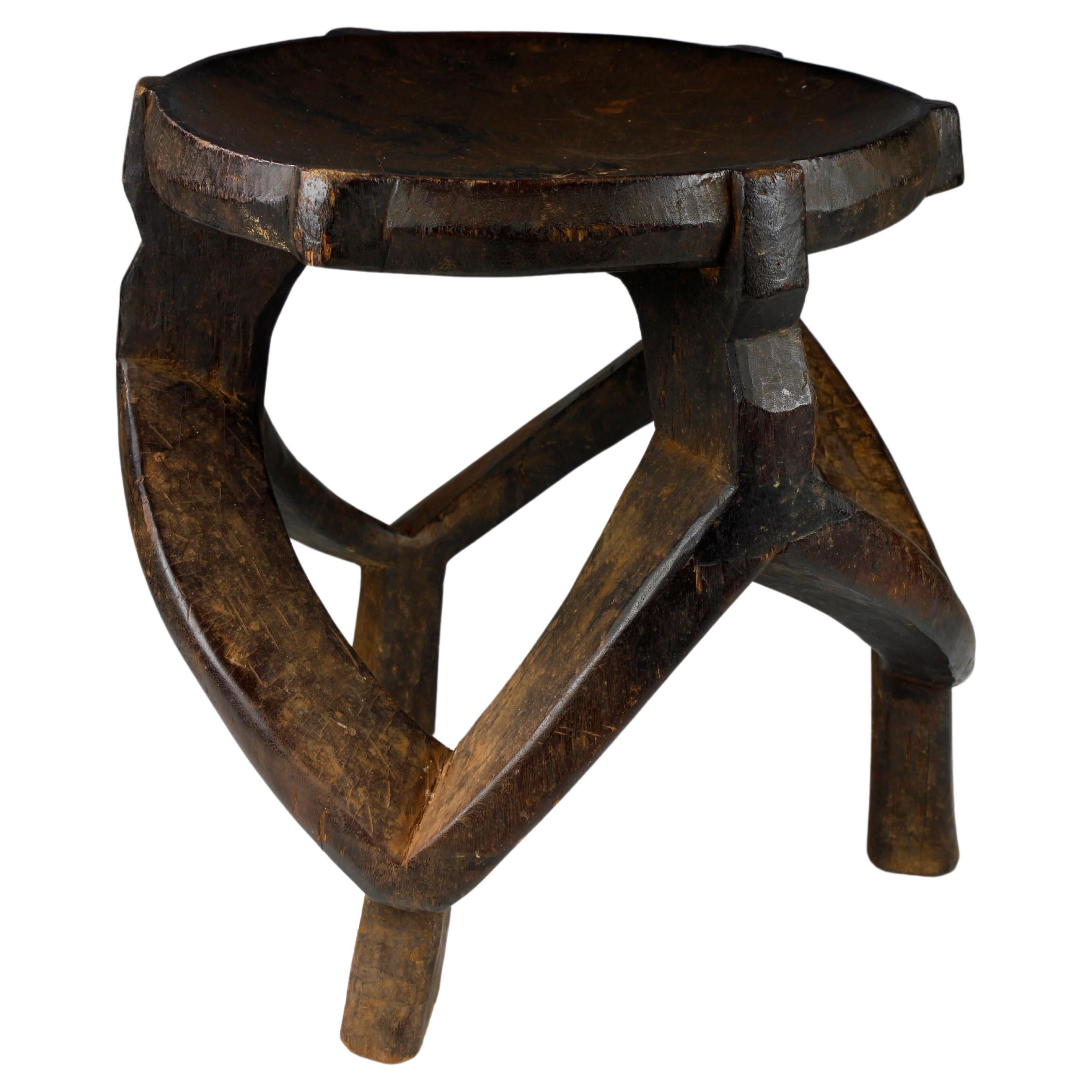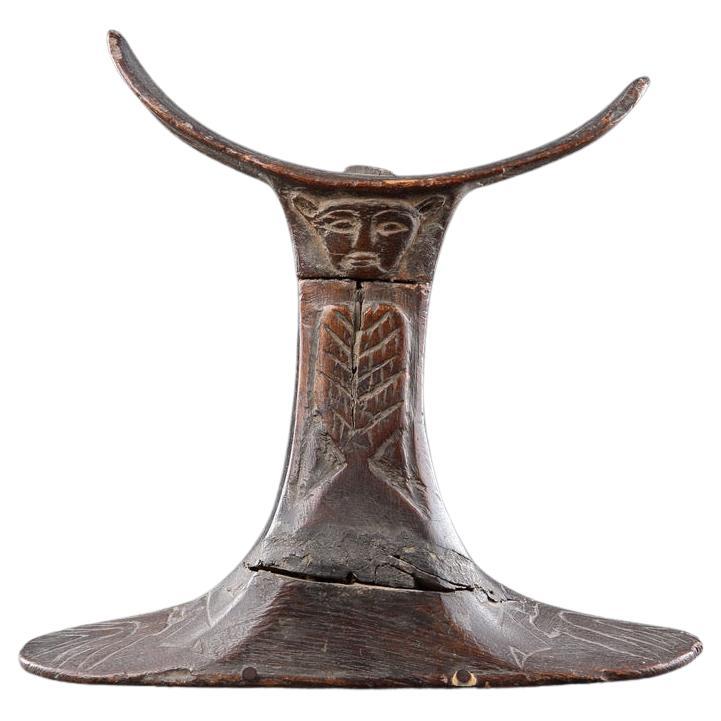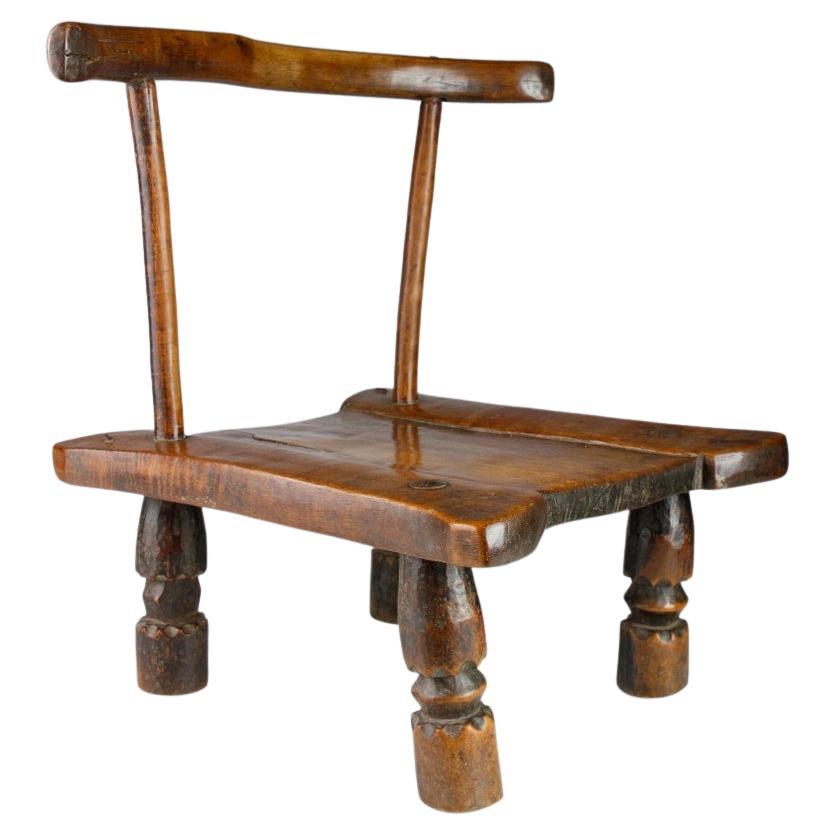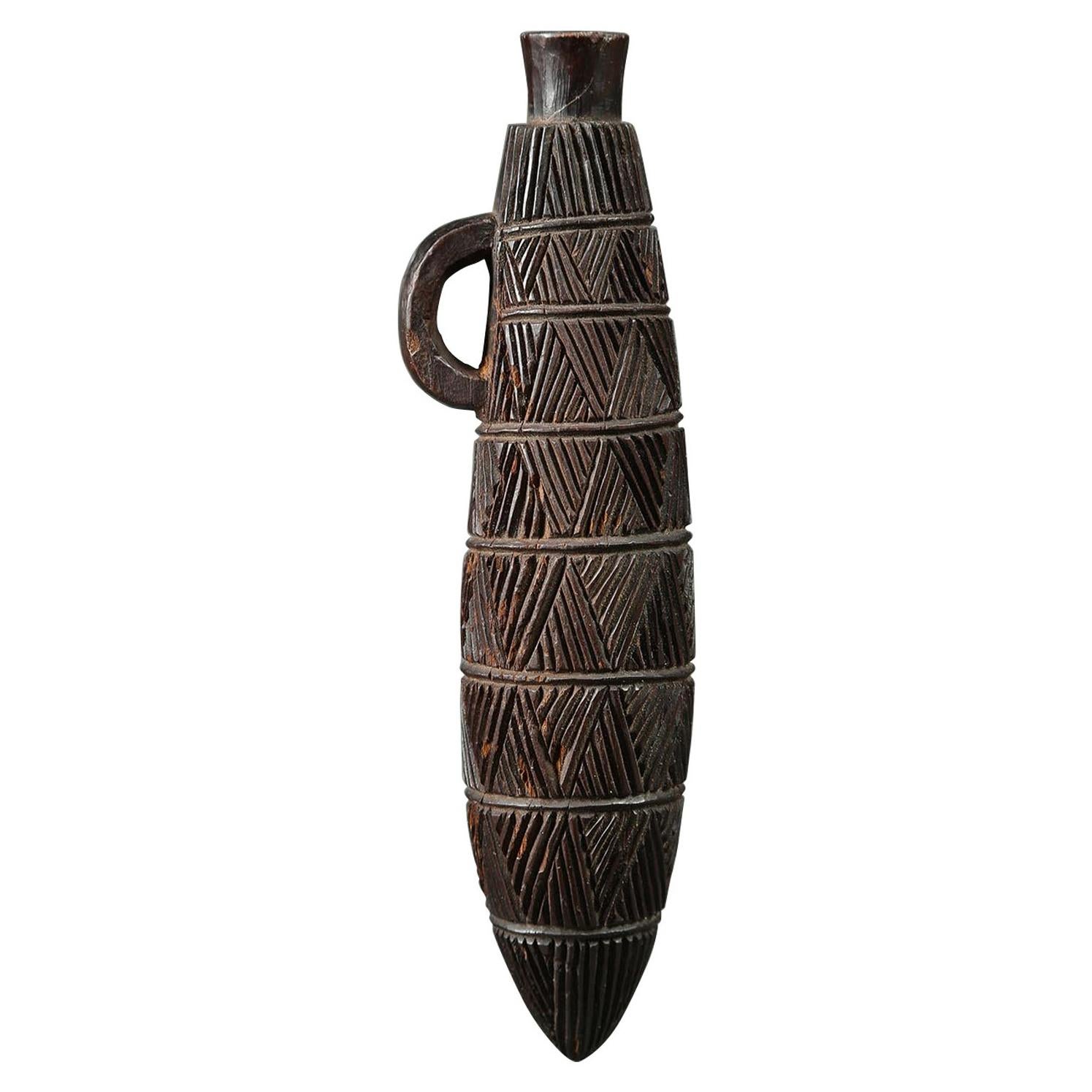Items Similar to A Finely Carved ‘Boni’ Neck-Rest
Want more images or videos?
Request additional images or videos from the seller
1 of 11
A Finely Carved ‘Boni’ Neck-Rest
About the Item
A Finely Carved ‘Boni’ Neck-Rest
Superb dark colour and patination through extended use
Wood
Somalia
19th Century
SIZE: 18.5cm high, 15.5cm wide - 7¼ ins high, 6 ins wide
These headrests are used by nomadic Somali men and women in southern Somalia and north-eastern Kenya. The male type, as in this fine old example, have a relatively small base and are therefore unstable, making deep undisturbed sleep difficult, and enhancing the men’s vigilance in the night. The women’s type have a more stable base.
The extensive Islamic influence in the region is reflected in the guilloche patterning carved on the sides of the headrest which ensures God’s protection for the sleeper.
Provenance:
Ex Susan Montiel-Colmenares, London, circa 1970
Ex Private collection
CF:
Pierre Loos, Bayet et Caltaux, ‘La tête dans les étoiles. Appuis-Nuque d’Afrique et d’ailleurs’, BRUNEAF, 2012: pg. 101
EXHIBITED:
BRUNEAF, Bruxelles, Belgium ‘La tête dans les étoiles’. Appuis-nuque d'Afrique et d’ailleurs’, 6 - 10 June 2012
- Dimensions:Height: 7.25 in (18.42 cm)Width: 6 in (15.24 cm)Depth: 0.5 in (1.27 cm)
- Materials and Techniques:
- Period:
- Date of Manufacture:19th Century
- Condition:Wear consistent with age and use.
- Seller Location:London, GB
- Reference Number:1stDibs: LU9363239430962
About the Seller
No Reviews Yet
Vetted Seller
These experienced sellers undergo a comprehensive evaluation by our team of in-house experts.
Established in 1989
1stDibs seller since 2023
- ShippingRetrieving quote...Ships From: London, United Kingdom
- Return PolicyA return for this item may be initiated within 14 days of delivery.
More From This SellerView All
- A Rare and Finely Carved Egyptian Wooden HeadrestLocated in London, GBA Rare and Finely Carved Egyptian Wooden Headrest with a Carved Head to both Sides Representing the God ‘Bes’ (Protector of the Homestead) above Carved...Category
Antique 15th Century and Earlier Egyptian Tribal Art
MaterialsWood
- A Rare and Exceptional Carved Headrest ‘Kali Hahapo’Located in London, GBA Rare and Exceptional Carved Headrest ‘Kali Hahapo’ Excellent colour and patina Wood, sennet (coconut fibre), glass beads Tonga Late 18th / Early 19th Century SIZE: 19cm high, 5...Category
Antique Early 19th Century Tongan Tribal Art
MaterialsNatural Fiber, Glass, Wood, Coconut
- A Rare and Historically Important Artefact Recovered from HMS Adventure in 1775Located in London, GBA Rare and Historically Important Artefact Recovered from HMS Adventure in 1775 after Captain James Cook’s Second Voyage to the Pacific A ‘coconut husker’ made by a ship’s carpenter aboard HMS Adventure in the style and design of a Native Islander’s ethnographical ‘coconut husker’ An engraved and inscribed copper plaque: A memento from The Sandwich Islands Coconut Husker used aboard HMS Adventure and recovered from The Royal Dockyard Deptford 1775 Oak, iron, brass, copper, handmade iron screws Fine rich colour and patina England / Sandwich Island 18th Century SIZE: 15.5cm high, 49.5cm long, 20cm wide (max) - 6¹⁄₈ ins high, 19½ ins long, 7⁷⁄₈ ins wide (max) Provenance: Found in a Scottish attic after centuries of lying hidden in a crate Ex Private Scottish collection Captain James Cook’s second voyage aboard the Resolution and accompanied by HMS Adventure set sail in July 1772. The discovery of the southern eight islands of the Sandwich Islands group was in 1775. The given name was chosen in honour of John Montagu, 4th Earl of Sandwich, First Lord of the Admiralty. The copper plaque and inscription however should not be read as The Sandwich Islands ‘Owhyhee’ (The Hawaiian Islands) which were later discovered on January 18th, 1778, on Captain Cook’s third voyage. Rather the inscription refers to ‘South Sandwich Islands’ lying to the south east of South Georgia and only renamed later with the word ‘South’ to distinguish them from the ‘Sandwich Islands’ now known as the Hawaiian Islands. Not withstanding during Cook’s second voyage he visited Easter Island, Tahiti, Society Islands, Niue, Tonga, New Hebrides, New Caledonia, Norfolk Islands, Palmerston Island and South Georgia. The crew onboard having been exposed to various types of ‘coconut huskers’ adapted those designs into the example we now see, having been rescued from HMS Adventure in 1775. A rare example of 18th century cross...Category
Antique 16th Century American Tribal Art
MaterialsBrass, Copper, Iron
- A Rare Anthropomorphic Tsonga HeadrestLocated in London, GBA Rare Anthropomorphic Tsonga Headrest An old paper label: ‘African Pillow Bt. Webster. Sep 1897. P.’ Fine colour and patina through use Wood, pigment, paper label Zimbabwe 19th...Category
Antique 19th Century Zimbabwean Tribal Art
MaterialsWood, Paper
- A Rare Wood Ear OrnamentLocated in London, GBA Rare Wood Ear Ornament With old collectors label ‘Ear Wood. Paraquay’ Wood Paraguay 19th Century Size: 6cm dia., 3.5cm deep - 2¼ ins dia., 1¼ ins deep Published: Steven Phe...Category
Antique 19th Century Paraguayan Tribal Art
MaterialsWood
- A Rare Spirit Mask ‘Barak’ or ‘Yamburai Parak’Located in London, GBA Rare Spirit Mask ‘Barak’ or ‘Yamburai Parak’ Wood, remains of polychrome Eastern Sepik Province, New Guinea Late 19th - early 20th Century SIZE: 45cm high, 35cm deep - 17¾ ins high, 13¾ ins deep Originally these masks were brightly coloured. However, after many years of exposure within the ceremonial houses the colour faded away through use and weathering. The mask was traditionally worn by a dancer whose plant fibre costume completely covered him, and was associated with an important male mythical being. The Barak (sometimes spelled ‘barag’ or ‘brag’) were situated to the west of the Sepik River. The Sepik River was first explored in 1885 by Otto Fisch. He wrote of the regions cultural diversity and beauty of the villages that he saw on the banks of the river over which towered the ‘men’s houses’. In the early 20th century collectors of primitive art were astounded at the sheer quantity of marvellous objects to be found in this region and the extraordinary inventiveness of the forms in this difficult swampy terrain. Provenance: Ex UK Art Market Ex Private collection CF ‘New Guinea Art...Category
Antique Late 19th Century Papua New Guinean Tribal Art
MaterialsWood
You May Also Like
- African Tribal Art Fine Shona Neck Rest Head RestLocated in London, GBA fine shona head rest neck rest Raised on a single central pillar finely carved with geometric designs Shona Zimbabwe Measures: Height 5 inches, width 6...Category
Antique 19th Century Zimbabwean Tribal Art
MaterialsWood
- African Tribal Art Fine Zulu Neck Rest Head Rest South AfricaLocated in London, GBA fine Zulu head rest neck rest South Africa Raised on central pillars with geometric lozenge shaped carving all over. Measures: 22 x 14 x 5 cm approx. Period Early 20th century Ex U...Category
Antique 19th Century Zimbabwean Tribal Art
MaterialsWood
- Finely Carved Tanzanian Chieftain's StoolLocated in London, GBThis beautifully carved title stool, from the Gogo culture in Tanzania, features a wonderful looped and adjoining structure. Dating back to the mid-twentieth century, this fine examp...Category
Mid-20th Century Tanzanian Tribal Tribal Art
MaterialsWood
- Early Twentieth-Century Finely Carved Small ChairLocated in London, GBThis early twentieth-century small chair displays a beautiful form. Typically low to the ground, such chairs are found among the Dan and Baule cultures in the Ivory Coast. Carved fro...Category
Early 20th Century Ivorian Tribal Tribal Art
MaterialsHardwood
- Zulu Tribal Carved Wood Snuff Container, South Africa Finely Carved IncisedLocated in Point Richmond, CAZulu Tribal carved wood Snuff Container, South Africa A finely carved snuff container with finely carved incised great geometric designs, a great example of the detailed work the Zu...Category
Early 20th Century South African Tribal Tribal Art
MaterialsWood
- Mid-Twentieth Century Finely Carved Food Bowl Depicting Two DucksLocated in London, GBThis fine mid-twentieth-century bowl, from the Lozi culture in Zambia, would have been traditionally used to serve and store food. The bowl's base has been made from a single piece of wood, and two beautifully carved ducks decorate the lid. Animals depicted on Lozi bowls were often species that could be found inhabiting the shores of the Zambezi River...Category
Mid-20th Century Zambian Tribal Tribal Art
MaterialsHardwood

